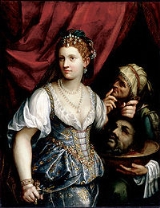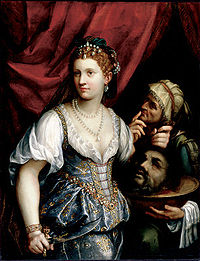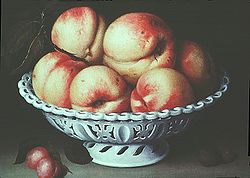
Fede Galizia
Encyclopedia
Fede Galizia was an Italian Renaissance
painter, a pioneer of the still life
genre.
 Fede Gallizi, better known as Galizia, was born in Milan
Fede Gallizi, better known as Galizia, was born in Milan
in 1578. Her father, Nunzio Galizia, also a painter of miniatures
, had moved to Milan from Trento
. Fede (whose name means "faith") learned to paint from him. By the age of twelve, she was sufficiently accomplished as an artist to be mentioned by Gian Paolo Lomazzo
, a painter and art theorist friend of her father, who wrote, "[T]his girl dedicates herself to imitate our most extraordinary art."
At a young age, Galizia was already an established portrait
painter handling many commissioned works. Perhaps it was her father's influence as a miniaturist that led to Galizia's attention to detail in her portraits. Her treatment of jewels and clothing made her a very desirable portrait painter. She was often commissioned to paint religious and secular themes as well. Several of her paintings based on the deuterocanonical story of Judith and Holofernes
, a popular theme in art of the period, survive in private collections. Perhaps her earliest was Judith and Her Handmaiden painted in 1596 which is now in Sarasota Florida at the Ringling Museum of Art. She also created miniatures and altarpieces for convents.
The style of her portraits derived from the naturalistic traditions of the Renaissance in Italy with a sharply realistic approach. Galizia's artistic skills of drawing and painting are evident in her Portrait of Paolo Morigia, a Jesuit scholar and one of her earliest patrons and supporters. Morigia, also a writer and historian, was very pleased with Galizia's work, and was portrayed in her 1596 Portrait of Paolo Morigia to be writing a poem about the picture Galizia was painting. She received several public commissions for altarpiece
s in Milanese churches; one of these was the Noli me tangere (1616; Milan, S Stefano) she made for the altar of Saint Maria Maddalena Church.
When not painting portraits, Galizia was primarily interested in painting still life
s, a genre in which she was a pioneer and for which she is best remembered. Although very few contemporary sources mention Galizia's still life paintings, they are the majority of her surviving works. Sixty-three works have been catalogued as hers, of which 44 are still lifes. One of her signed still lifes made in 1602 is said to be the first dated still life by an Italian artist, and proves her involvement in this new style of painting.
Galizia never married. On June 21, 1630, she made her will and is thought to have died of the plague in Milan shortly afterward.
 Fede Galizia painted portraits, miniatures and altarpieces, but the most important part of her oeuvre, for which she earned her place in art history, is her still lifes. However, her paintings were not given the recognition they deserve until well into the 20th century, when special attention was given to her work in studies made in 1963 and 1989. It was only then when she was rescued from oblivion.
Fede Galizia painted portraits, miniatures and altarpieces, but the most important part of her oeuvre, for which she earned her place in art history, is her still lifes. However, her paintings were not given the recognition they deserve until well into the 20th century, when special attention was given to her work in studies made in 1963 and 1989. It was only then when she was rescued from oblivion.
Galizia shows a style related to the Lombard mannerism
of the late 16th century, centered in Mantua
, but known internationally, especially in France
. Galizia’s still lifes are among the earliest examples of painting in a new genre in which women, partly because they were excluded from other kinds of painting, would excel.
Galizia’s still lifes differ from her father's works in their greater detail and more vibrant colors. Most of these works featured fruit centerpieces in simple, frontal arrangements. They usually featured a basket or bowl filled with a single type of fruit, such as peaches or pears, with a few fruit, sometimes sliced, scattered at the base of the bowl.
Many of her still lifes had fresh flowers or other fruits set on the counter to provide a noticeable contrast and scale as seen in her work titled, Still-life with Peaches and a Porcelain and a Bowl. Galizia's work displayed influences from such works as Caravaggio
's Basket of Fruit. Associating with the more restrained style of the Counter Reformation period, she did not explore the more lavish compositions and forms taken up by many of her contemporaries working in this genre; she preferred instead to use a stricter, more simplistic style like that seen in Francisco de Zurbarán's slightly later still life paintings.
Galizia’s paintings were deft with detail, perfectly balanced, and her attention to shadow, light, and texture was unrivalled at the time. She was particularly good at creating inviting space in her paintings. Her compositions are not crowded. They look as if one could reach out and touch the fruit, grasp it, and pull it from the painting without disturbing the rest of the work. Her graceful, flowing arrangements were natural and poetic, unlike their contrived predecessors.
Galizia aesthetic treatment of still lifes would not be seen again until the middle of the century. The modern direction taken in still life painting was shaped entirely by her works. Many of the still life paintings we see today draw their influence from her original ideas. Currently, it is unknown just how many paintings Galizia was responsible for. Many works that could have possibly been hers have been attributed to her male counterpart Panfilo Nuvolone
, who drew significant inspiration from Galizia. She may have inspired the Bergamese Francesco Codino and the Baroque
still life painter, also a woman, Giovanna Garzoni
.
Renaissance
The Renaissance was a cultural movement that spanned roughly the 14th to the 17th century, beginning in Italy in the Late Middle Ages and later spreading to the rest of Europe. The term is also used more loosely to refer to the historical era, but since the changes of the Renaissance were not...
painter, a pioneer of the still life
Still life
A still life is a work of art depicting mostly inanimate subject matter, typically commonplace objects which may be either natural or man-made...
genre.
Life

Milan
Milan is the second-largest city in Italy and the capital city of the region of Lombardy and of the province of Milan. The city proper has a population of about 1.3 million, while its urban area, roughly coinciding with its administrative province and the bordering Province of Monza and Brianza ,...
in 1578. Her father, Nunzio Galizia, also a painter of miniatures
Miniature (illuminated manuscript)
The word miniature, derived from the Latin minium, red lead, is a picture in an ancient or medieval illuminated manuscript; the simple decoration of the early codices having been miniated or delineated with that pigment...
, had moved to Milan from Trento
Trento
Trento is an Italian city located in the Adige River valley in Trentino-Alto Adige/Südtirol. It is the capital of Trentino...
. Fede (whose name means "faith") learned to paint from him. By the age of twelve, she was sufficiently accomplished as an artist to be mentioned by Gian Paolo Lomazzo
Gian Paolo Lomazzo
Gian Paolo Lomazzo was an Italian painter, more remembered for his writings on art theory, belonging to the second generation that produced Mannerism in Italian art and architecture.Gian Paolo Lomazzo was born in Milan from a family emigrated from the town of Lomazzo...
, a painter and art theorist friend of her father, who wrote, "[T]his girl dedicates herself to imitate our most extraordinary art."
At a young age, Galizia was already an established portrait
Portrait
thumb|250px|right|Portrait of [[Thomas Jefferson]] by [[Rembrandt Peale]], 1805. [[New-York Historical Society]].A portrait is a painting, photograph, sculpture, or other artistic representation of a person, in which the face and its expression is predominant. The intent is to display the likeness,...
painter handling many commissioned works. Perhaps it was her father's influence as a miniaturist that led to Galizia's attention to detail in her portraits. Her treatment of jewels and clothing made her a very desirable portrait painter. She was often commissioned to paint religious and secular themes as well. Several of her paintings based on the deuterocanonical story of Judith and Holofernes
Holofernes
In the deuterocanonical Book of Judith Holofernes was an invading general of Nebuchadnezzar. Nebuchadnezzar dispatched Holofernes to take vengeance on the nations of the west that had withheld their assistance to his reign...
, a popular theme in art of the period, survive in private collections. Perhaps her earliest was Judith and Her Handmaiden painted in 1596 which is now in Sarasota Florida at the Ringling Museum of Art. She also created miniatures and altarpieces for convents.
The style of her portraits derived from the naturalistic traditions of the Renaissance in Italy with a sharply realistic approach. Galizia's artistic skills of drawing and painting are evident in her Portrait of Paolo Morigia, a Jesuit scholar and one of her earliest patrons and supporters. Morigia, also a writer and historian, was very pleased with Galizia's work, and was portrayed in her 1596 Portrait of Paolo Morigia to be writing a poem about the picture Galizia was painting. She received several public commissions for altarpiece
Altarpiece
An altarpiece is a picture or relief representing a religious subject and suspended in a frame behind the altar of a church. The altarpiece is often made up of two or more separate panels created using a technique known as panel painting. It is then called a diptych, triptych or polyptych for two,...
s in Milanese churches; one of these was the Noli me tangere (1616; Milan, S Stefano) she made for the altar of Saint Maria Maddalena Church.
When not painting portraits, Galizia was primarily interested in painting still life
Still life
A still life is a work of art depicting mostly inanimate subject matter, typically commonplace objects which may be either natural or man-made...
s, a genre in which she was a pioneer and for which she is best remembered. Although very few contemporary sources mention Galizia's still life paintings, they are the majority of her surviving works. Sixty-three works have been catalogued as hers, of which 44 are still lifes. One of her signed still lifes made in 1602 is said to be the first dated still life by an Italian artist, and proves her involvement in this new style of painting.
Galizia never married. On June 21, 1630, she made her will and is thought to have died of the plague in Milan shortly afterward.
Style

Galizia shows a style related to the Lombard mannerism
Mannerism
Mannerism is a period of European art that emerged from the later years of the Italian High Renaissance around 1520. It lasted until about 1580 in Italy, when a more Baroque style began to replace it, but Northern Mannerism continued into the early 17th century throughout much of Europe...
of the late 16th century, centered in Mantua
Mantua
Mantua is a city and comune in Lombardy, Italy and capital of the province of the same name. Mantua's historic power and influence under the Gonzaga family, made it one of the main artistic, cultural and notably musical hubs of Northern Italy and the country as a whole...
, but known internationally, especially in France
France
The French Republic , The French Republic , The French Republic , (commonly known as France , is a unitary semi-presidential republic in Western Europe with several overseas territories and islands located on other continents and in the Indian, Pacific, and Atlantic oceans. Metropolitan France...
. Galizia’s still lifes are among the earliest examples of painting in a new genre in which women, partly because they were excluded from other kinds of painting, would excel.
Galizia’s still lifes differ from her father's works in their greater detail and more vibrant colors. Most of these works featured fruit centerpieces in simple, frontal arrangements. They usually featured a basket or bowl filled with a single type of fruit, such as peaches or pears, with a few fruit, sometimes sliced, scattered at the base of the bowl.
Many of her still lifes had fresh flowers or other fruits set on the counter to provide a noticeable contrast and scale as seen in her work titled, Still-life with Peaches and a Porcelain and a Bowl. Galizia's work displayed influences from such works as Caravaggio
Caravaggio
Michelangelo Merisi da Caravaggio was an Italian artist active in Rome, Naples, Malta, and Sicily between 1593 and 1610. His paintings, which combine a realistic observation of the human state, both physical and emotional, with a dramatic use of lighting, had a formative influence on the Baroque...
's Basket of Fruit. Associating with the more restrained style of the Counter Reformation period, she did not explore the more lavish compositions and forms taken up by many of her contemporaries working in this genre; she preferred instead to use a stricter, more simplistic style like that seen in Francisco de Zurbarán's slightly later still life paintings.
Galizia’s paintings were deft with detail, perfectly balanced, and her attention to shadow, light, and texture was unrivalled at the time. She was particularly good at creating inviting space in her paintings. Her compositions are not crowded. They look as if one could reach out and touch the fruit, grasp it, and pull it from the painting without disturbing the rest of the work. Her graceful, flowing arrangements were natural and poetic, unlike their contrived predecessors.
Galizia aesthetic treatment of still lifes would not be seen again until the middle of the century. The modern direction taken in still life painting was shaped entirely by her works. Many of the still life paintings we see today draw their influence from her original ideas. Currently, it is unknown just how many paintings Galizia was responsible for. Many works that could have possibly been hers have been attributed to her male counterpart Panfilo Nuvolone
Panfilo Nuvolone
Panfilo Nuvolone was an Italian painter of the Mannerist period, who painted both religious and still life topics, active in Cremona and Mantua....
, who drew significant inspiration from Galizia. She may have inspired the Bergamese Francesco Codino and the Baroque
Baroque
The Baroque is a period and the style that used exaggerated motion and clear, easily interpreted detail to produce drama, tension, exuberance, and grandeur in sculpture, painting, literature, dance, and music...
still life painter, also a woman, Giovanna Garzoni
Giovanna Garzoni
Giovanna Garzoni was an Italian painter of the Baroque era. She was unusual for Italian artists of thetime for two reasons: first, in that her themes were mainly decorative and luscious still-lifes of fruits, vegetables, and flowers, and second, because she was a woman.Garzoni was born in Ascoli...
.

